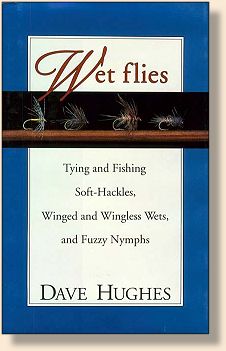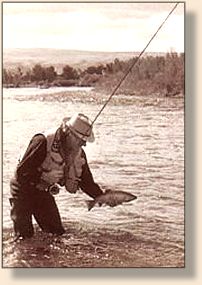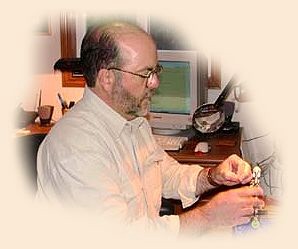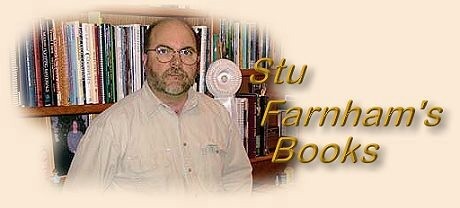|
The Internet is a powerful resource. It provides us instant
access to information, and brings us together via email,
bulletin boards, chat rooms, and instant messaging. FAOL
is a wonderful example of the Internet at its best. The Internet,
however, will never replace the printed page.
I've loved books and fishing since my youngest years, although
I did not start fly fishing until 1993. This column will give
me an opportunity to share reviews of some of my favorite fly
fishing and tying books (and some that are not such favorites)
with my friends here at FAOL. My library reflects my tastes
and interests, and so will this column. It will be heavily
slanted towards cold water fishing and tying for trout and
steelhead, and won't touch much on areas of which I know little,
such as warm or salt water fishing.
I hope that these reviews will motivate some of you to pick up
a good book, on this or any subject, and read.
~ Stu Farnham
Wet Flies: Tying and Fishing Soft-Hackles,
Winged and Wingless Wets, and Fuzzy Nymphs
 Wet Flies
Wet Flies
By Dave Hughes
Hardcover: 240 pages
Stackpole Books (March 1995)
ISBN: 0811718689
If you were going to be sent to a desert island and could
only take one book related to fly fishing and tying, what
would that book be? Several titles call out as I scan my
bookshelves looking for a candidate: The Fly Tier's
Benchside Reference is a solid, practical choice
(assuming I'll be allowed to take my tying tools and materials).
Ernest Schwiebert's Trout contains a quantity and
quality of material to provide for an extended stay. Pryce-Tannet
on salmon flies, Ted Leeson's The Habit of Rivers,
anything by Gary LaFontaine. My choice, however, would be Dave
Hughes' Wet Flies.
This is a modest book in the best sense of the word, understated,
gentle in tone, and respectful of its subject matter. Instead of
reaching for breadth, it tries to cover one area thoroughly. In
a certain sense the book is a memoir of four men who influenced
Hughes. The core of the book is built around the flies and fishing
of Sylvester Nemes, Polly Rosborough, and Jim Leisenring and Pete
Hidy (whose names are inextricably linked).
The book begins by recounting some of Dave's own experiences fishing
wet flies over mayfly, caddis, and stonefly hatches, and mentions
two of my favorite wet flies and hatches under which to fish them:
the March Brown Flymph (for the Western March brown) and the Mother's
Day Caddis soft hackle (for the blanket grannom hatches on Oregon's
McKenzie River).
Next comes a brief overview of the history of the wet fly in the
angling literature of Europe. Of particular note here are the works
of W.C., of Scotland, who codified much of what we know about North
Country soft hackles and spiders, and G.E.M.Skues, who quietly but
effectively challenged Halford's dry fly dogma. This is followed
by a chapter reviewing the wet fly in North American fly fishing
literature, from Ray Bergman through Leisenring and Hidy, Polly
Rosborough, and Syl Nemes, to Gary LaFontaine's work on subsurface
caddisflies.
Part two of the book contains detailed information on tying the
four styles into which Hughes classifies wet flies: soft hackles
(and spiders), the wingless wet flies which Pete Hidy called 'flymphs,'
traditional winged wets, and fuzzy nymphs, including generic nymphs
such as the gold ribbed hare's ear, nymphs in the distinctive style
of Polly Rosborough, and Dave's own fur hackled wets. Materials
and methods are discussed with clarity and detail. The photographs,
although black and white, provide an excellent pictorial accompaniment
to the text.
 Flies, once tied, need to be fished, and Hughes moves on to discuss
tackle and technique. The discussion of technique divides the water
into the surface (on and just below), and the middle and bottom
levels. Crisp illustrations by Richard Bunse show the methods
from the text in application. There follows a chapter on the
specific subsurface techniques associated with Nemes, Leisenring,
Hidy, and Rosborough. Dave spends a lot of time fishing the small
streams of Oregon's coast range, and some of his best writing
concerns his time on small waters. The section on technique closes
with a chapter on subsurface methods applied to small creeks.
Flies, once tied, need to be fished, and Hughes moves on to discuss
tackle and technique. The discussion of technique divides the water
into the surface (on and just below), and the middle and bottom
levels. Crisp illustrations by Richard Bunse show the methods
from the text in application. There follows a chapter on the
specific subsurface techniques associated with Nemes, Leisenring,
Hidy, and Rosborough. Dave spends a lot of time fishing the small
streams of Oregon's coast range, and some of his best writing
concerns his time on small waters. The section on technique closes
with a chapter on subsurface methods applied to small creeks.
For the hatch matchers, there are chapters on subsurface presentation
as applied to mayflies, caddis, and stoneflies, and one on midges and
alderflies. The book includes ten color plates, each illustrating
half a dozen of the wet fly patterns described in the book and
including recipes.
I first read this book shortly after it was released in 1995. At that
time I was on the cusp of the transition from novice to intermediate
fly fisher, and had been tying at least some of my own flies for a
year or so. I went on from 'Wet Flies' to read many of the works
mentioned through the book. My columns for the rest of the month
of May will cover the major influences on Wet Flies:
Syl Nemes' books on soft hackles, Polly Rosborough's Tying and
Fishing the Fuzzy Nymphs, and Leisenring'/Hidy's The Art
of Tying the Wet Fly & Fishing the Flymph.
I hope that you all enjoy reading these columns as much as I enjoy
writing them. Your comments, positive or negative, and your suggestions
for future columns, are welcome. Please feel free to email me at
stu@starband.net. And, if
you make your way to the Pacific Northwest, give me a shout.
We'll go fish together. ~ Stu Farnham
About Stu
 Stu Farnham is a New Englander by birth, who was transplanted to
and put down roots in Oregon in the early 1990s. A software
engineering manager by vocation, he can be found in his spare
time chasing trout and steelhead in the rivers of the Pacific
Northwest, chasing his four Gordon Setters (who in turn are
chasing chukar), tying flies, reading, or working on his website.
Colleen, his long suffering wife of 28 years, is a professionally
trained personal chef.
Stu Farnham is a New Englander by birth, who was transplanted to
and put down roots in Oregon in the early 1990s. A software
engineering manager by vocation, he can be found in his spare
time chasing trout and steelhead in the rivers of the Pacific
Northwest, chasing his four Gordon Setters (who in turn are
chasing chukar), tying flies, reading, or working on his website.
Colleen, his long suffering wife of 28 years, is a professionally
trained personal chef.
|



